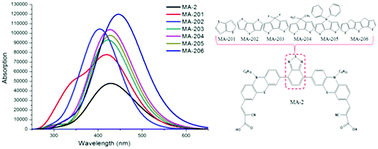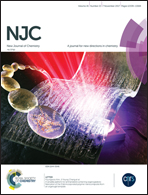Double-anchoring organic dyes for dye-sensitized solar cells: the opto-electronic property and performance†
Abstract
A series of A–D–π–D–A double-anchoring organic dyes (MA-201–MA-206) with different core spacers were designed to investigate the optoelectronic property and to develop their utility in solar cell. The short-circuit current density (JSC) and open-circuit voltage (VOC) can be directly estimated from simulated micro-parameters, and the influence of nature of core spacers on the efficiency was compared and investigated. The results reveal that dyes MA-201–MA-206 have narrower energy gap and higher molar extinction coefficient compared with the referenced dye (MA-2), and designed molecules (MA-201–MA-206) also exhibit the higher light-harvesting efficiency, electron accepting power and lower driving force of electron injection, chemical hardness as well as reorganization energy. Among the designed dyes, electron injection time on femtosecond (fs) scale for MA-201, MA-203 and MA-206 is smaller than that of MA-2, meaning that electron injection from excited state into TiO2 should take place easily. Those parameters suggested that the designed molecules should have the higher JSC, and dyes MA-201–MA-206 have higher dipole moment unormal, which will increase the VOC. Furthermore, one anchoring model and two anchoring models were compared from the energy level and spectra and driving force. It is expected that the dyes (MA-201–MA-206) will be potential candidates, in which dye MA-206 with increasing cyclopentadithiophene core displays the best performance in the designed system. Comparative investigation can provide a train of thought to design and screen out high performance dyes.



 Please wait while we load your content...
Please wait while we load your content...